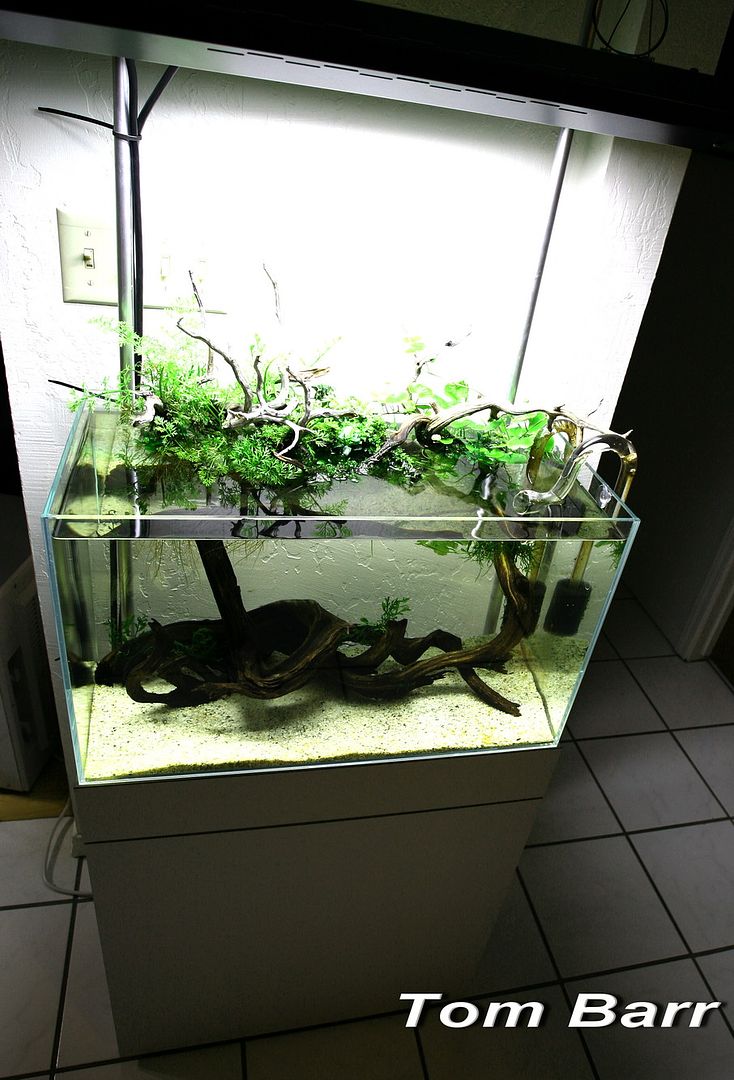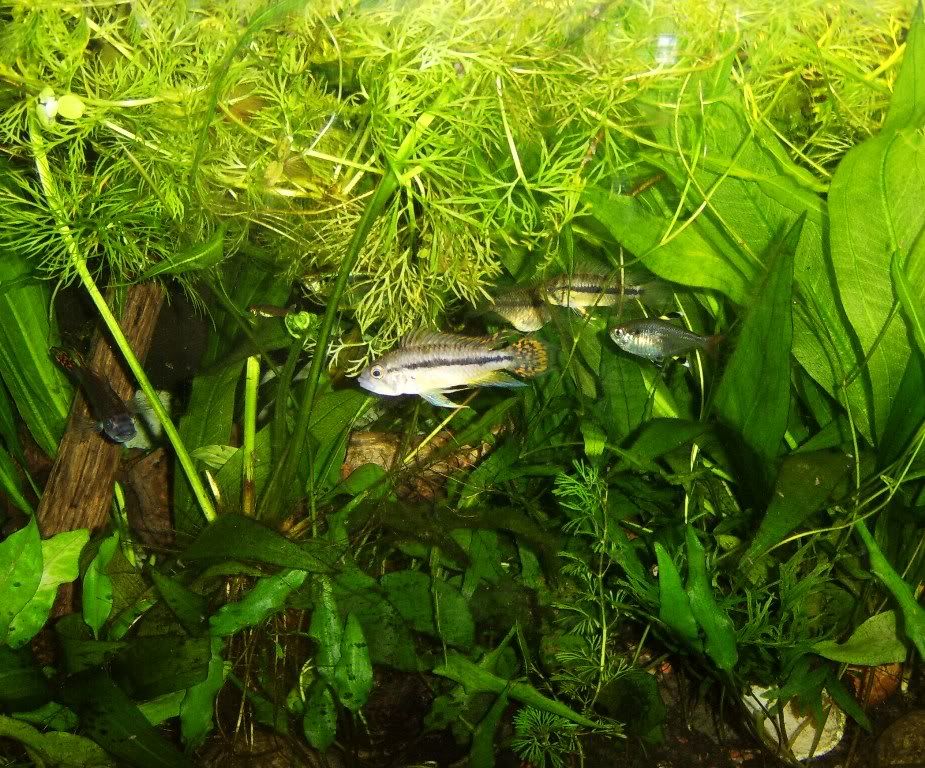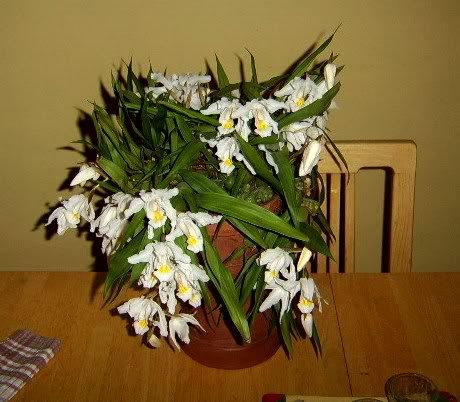In an attempt to get some of my Apistos spawning I made the investment in a RO/DI unit and a conductivity meter. First I checked the conductivity of my tap water and got a value of 320µS, next I checked the RO/DI water and got a value of 1.7µS, so the unit is working well. Before doing a water change I decided to check the conductivity in my tanks and I got readings from 540µS to 980µS  in my 100 gallon bitaeniata tank. All of the tanks are very well planted and receive daily doses of either micro (trace elements) or macro nutrients (KN03, KH2P04 and K2S04). My question is can the plant nutrients be responsible for raising the conductivity or should I be looking at another culprit?
in my 100 gallon bitaeniata tank. All of the tanks are very well planted and receive daily doses of either micro (trace elements) or macro nutrients (KN03, KH2P04 and K2S04). My question is can the plant nutrients be responsible for raising the conductivity or should I be looking at another culprit?
-
Hello guest! Are you an Apistogramma enthusiast? If so we invite you to join our community and see what it has to offer. Our site is specifically designed for you and it's a great place for Apisto enthusiasts to meet online. Once you join you'll be able to post messages, upload pictures of your fish and tanks and have a great time with other Apisto enthusiasts. Sign up today!
You are using an out of date browser. It may not display this or other websites correctly.
You should upgrade or use an alternative browser.
You should upgrade or use an alternative browser.
Conductivity and Fertilizers
- Thread starter svtcanuk
- Start date
- Messages
- 577
- Location
- Nottingham, UK
Along with lots of other things that up the TDS in the tank, ferts raise it hugely IME. They are pretty much all salts of one kind or another and so the conductivity goes way up!
I found that some of my killies and dwarfs seemed to not lay eggs when the TDS was too high, even though I was using pure RO water with just a bit of remineralising salts to give 3-4dGH, 0dKH. When I cut back the ferts and upped the water changes the killies started laying straight away (followed by the apistos in that tank), but I have heard plenty of other people getting good results with dwarfs with the ferts at high levels so I'm not prepared to lay the blame totally at their door - it was just my experience.
Try adding your a dose of your ferts to some RO water and see what the conductivity is with that. It might give you a hint as to what proportion of the tank's readings are down to your ferts.
I found that some of my killies and dwarfs seemed to not lay eggs when the TDS was too high, even though I was using pure RO water with just a bit of remineralising salts to give 3-4dGH, 0dKH. When I cut back the ferts and upped the water changes the killies started laying straight away (followed by the apistos in that tank), but I have heard plenty of other people getting good results with dwarfs with the ferts at high levels so I'm not prepared to lay the blame totally at their door - it was just my experience.
Try adding your a dose of your ferts to some RO water and see what the conductivity is with that. It might give you a hint as to what proportion of the tank's readings are down to your ferts.
- Messages
- 317
- Location
- Argentina
I´ve studied ant tested this matter very deeply. I´ll try to explain it in my poor english.
The fertilizers do raise TDS. But there´s no problem in fertilizing the tank, the issue is how you fertilize.
If you follow something like Tom Barr´s method, there´s no way to keep low TDS.
You´ve to fertilize the water column (fertilizing the substrate don´t change the TDS if the substrate don´t touch the water column) daily (or once for every two or three days) with the exact amount of micros and macros that your tank consume in a day (or in two or three days, depending your freq. fertilizing).
If you follow this advice, your TDS will stay in the level you want (you can maintain it as much as 50 us).
Of course, there´s no problem in spawning some Apistos with 600 us in TDS (borellii, commbrae, trifasciata, line bred cacatuoides, sp. "Rotpunkt" -I guess alacrina as well-, etc)
The fertilizers do raise TDS. But there´s no problem in fertilizing the tank, the issue is how you fertilize.
If you follow something like Tom Barr´s method, there´s no way to keep low TDS.
You´ve to fertilize the water column (fertilizing the substrate don´t change the TDS if the substrate don´t touch the water column) daily (or once for every two or three days) with the exact amount of micros and macros that your tank consume in a day (or in two or three days, depending your freq. fertilizing).
If you follow this advice, your TDS will stay in the level you want (you can maintain it as much as 50 us).
Of course, there´s no problem in spawning some Apistos with 600 us in TDS (borellii, commbrae, trifasciata, line bred cacatuoides, sp. "Rotpunkt" -I guess alacrina as well-, etc)
- Messages
- 2,770
- Location
- Wiltshire UK
Hi all,
Just as the other poster said it is the fertilisers that are raising the conductivity, it is a measure of the salts in solution and KNO3 etc are exactly that, salts. I aim to keep the conductivity below 150 MicroS with a daily 10% water change, and tend to ignore pH, NO3 levels etc.
Personally I don't think that plants and very low nutrient conditions are mutually exclusive, you just need slow growing plants that are adapted to very low nutrient conditions. I have corresponded with Tom Barr about EI (Estimative Index), and he has done a lot of research on nutrients in planted aquariums, which is how he came up with EI as a high tech method that worked, gave a recipe for those without "green fingers" to follow and did away with the need for test kits etc. But IE is only one option, if you like this is a mountain with many peaks, not just one. His research has also indicated that fluctuating nutrient, and particularly CO2 levels, cause problems and algal outbreaks, and therefore if water changes are minimised (in non EI tanks), CO2 level fluctuations are minimised. I haven't done any research on CO2 levels in Aquariums, but I would be very surprised if that is a valid finding.
Even Tom keeps his L46 (Hypancistrus zebra) in a planted tank with no fertilizer or CO2 and regular water changes.

I think about like growing terrestrial plants, if you grow for example Tomatoes they need to grow fast, they need regular feeding, warmth, lots of light, lots of water and are very productive. If you grow Bromeliads, Fern and Orchids they don't grow very quickly what ever you do them and high levels of nutrients are actively damaging .
Here is my "none plant fed" A. cacatuoides tank:
 and this is dining room orchid (Coelogyne cristata) just before I re-potted it and several years without any fertilisers at all.
and this is dining room orchid (Coelogyne cristata) just before I re-potted it and several years without any fertilisers at all.

As long as you supply sufficient light (and water) plants will grow. In my experience mosses, ferns, Anubias, Cryptocoryne, Echinodorus, Nymphaea, Potamogeton gayii, Limnophila and the "floaters" Limnobium, Salvinia, Pistia, Ceratopteris all are fine on very lean rations. My suspicion would be that the majority of successful Apisto keepers keep both plants and very low conductivity, high quality water, partially because maintenance of water quality is much easier in planted aquariums.
cheers Darrel
Just as the other poster said it is the fertilisers that are raising the conductivity, it is a measure of the salts in solution and KNO3 etc are exactly that, salts. I aim to keep the conductivity below 150 MicroS with a daily 10% water change, and tend to ignore pH, NO3 levels etc.
Personally I don't think that plants and very low nutrient conditions are mutually exclusive, you just need slow growing plants that are adapted to very low nutrient conditions. I have corresponded with Tom Barr about EI (Estimative Index), and he has done a lot of research on nutrients in planted aquariums, which is how he came up with EI as a high tech method that worked, gave a recipe for those without "green fingers" to follow and did away with the need for test kits etc. But IE is only one option, if you like this is a mountain with many peaks, not just one. His research has also indicated that fluctuating nutrient, and particularly CO2 levels, cause problems and algal outbreaks, and therefore if water changes are minimised (in non EI tanks), CO2 level fluctuations are minimised. I haven't done any research on CO2 levels in Aquariums, but I would be very surprised if that is a valid finding.
Even Tom keeps his L46 (Hypancistrus zebra) in a planted tank with no fertilizer or CO2 and regular water changes.

I think about like growing terrestrial plants, if you grow for example Tomatoes they need to grow fast, they need regular feeding, warmth, lots of light, lots of water and are very productive. If you grow Bromeliads, Fern and Orchids they don't grow very quickly what ever you do them and high levels of nutrients are actively damaging .
Here is my "none plant fed" A. cacatuoides tank:


As long as you supply sufficient light (and water) plants will grow. In my experience mosses, ferns, Anubias, Cryptocoryne, Echinodorus, Nymphaea, Potamogeton gayii, Limnophila and the "floaters" Limnobium, Salvinia, Pistia, Ceratopteris all are fine on very lean rations. My suspicion would be that the majority of successful Apisto keepers keep both plants and very low conductivity, high quality water, partially because maintenance of water quality is much easier in planted aquariums.
cheers Darrel
- Messages
- 703
- Location
- Clarkston, WA
I am of the same philosophy as you guys, that is use fertilizers either not at all and use low light plants or restrict fertilizers to substrate types preferably in a pot. I often make low lying pots from the bottoms of clear plastic juice bottles or Gladware food containers and conceal them in the substrate. Enough fertilizer no doubt manages to escape the substrate in a pot to supply sufficient trace mineral for other plants.
I have one extreme environment tank set up for 24 Black Darter Tetras, Poeciliocharax weitzmani and a tiny suckermouth catfish, 14 Parotocinclus cf. epplyei. It is a 20 gal. long with a pH of of 3.7, and the TDS is always less than 20 ppm. I only use straight unreconstituted RO water for water changes but the slight TDS is sustained by the fertilizer that makes it's way into the water column. I have 2 potted Cyperus helfneri and all the wood and 2 large sponge filters ar carpeted by Singapore Moss which need little fertilization but the C. helfneri does benefit greatly from being fertilized. I use NutriFin Plant Grow Sticks timed release fertilizers. I just cut one spike in two with a hacksaw and used one half in each potted plant.
I have one extreme environment tank set up for 24 Black Darter Tetras, Poeciliocharax weitzmani and a tiny suckermouth catfish, 14 Parotocinclus cf. epplyei. It is a 20 gal. long with a pH of of 3.7, and the TDS is always less than 20 ppm. I only use straight unreconstituted RO water for water changes but the slight TDS is sustained by the fertilizer that makes it's way into the water column. I have 2 potted Cyperus helfneri and all the wood and 2 large sponge filters ar carpeted by Singapore Moss which need little fertilization but the C. helfneri does benefit greatly from being fertilized. I use NutriFin Plant Grow Sticks timed release fertilizers. I just cut one spike in two with a hacksaw and used one half in each potted plant.
Thank you all for the wealth of information. Just when you think you have these little fish figured out they throw you for a loop. Before my weekly water change this morning I noticed one of my female bitaeniata being particularly protective of her territory. I though to myself "no way" so I grab a flashlight and have a look inside her cave only to see a small group of eggs. I guess these wild bitaeniata are not as particular when it comes to conductivity as I would have though. The only other parameter that I was able to measure was pH which was at 6.8, I do not have a hardness test kit.
In the future I will take all of your recommendations into consideration although I don't think I can drop the ferts completely I will keep a close eye on the conductivity which should tell me if I am adding more nutrients than my plants can consume.
In the future I will take all of your recommendations into consideration although I don't think I can drop the ferts completely I will keep a close eye on the conductivity which should tell me if I am adding more nutrients than my plants can consume.
Similar threads
- Replies
- 18
- Views
- 2K